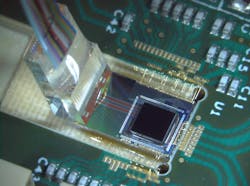COSMICC project leverages silicon nitride for 100-Gbps optical module
Members of the EU H2020 COSMICC (CmOs Solutions for Mid-board Integrated transceivers with breakthrough Connectivity at ultra-low Cost) project have demonstrated a fully packaged 2x50-Gbps CWDM optical transceiver module that leverages broadband, temperature-insensitive silicon nitride (SiN) multiplexing components on silicon (Si), the integration of hybrid III-V/Si lasers on the Si/SiN chips, and a high-count adiabatic fiber-coupling technique via SiN and polymer waveguides. According to project member CEA-LETI, the approach offers a path toward low-cost, low-power, reduced complexity optical engines for data center and supercomputer applications requiring capacity beyond terabits per second.
SiN is 10X less sensitive to temperature than silicon, say the project members. Use of the technology can therefore significantly reduce transceiver cost and power consumption by eliminating the need for temperature control through reduced heat output. The CWDM module features a silicon photonic chip that integrates 50-Gbps NRZ optical modulators and photodetectors, and a two-channel CWDM multiplexer and demultiplexer. The control electronics exhibits an optimized energy consumption level of 5.7 pJ/bit per channel at the 50-Gbps data rate.
Project participants also have created the building blocks necessary to enable a 4x50G device. They’ve developed a library of building blocks for higher data-rate data center interconnects as well. The developments leveraged STMicroelectronics’ silicon photonics integration platform.
“The new building blocks are essential for addressing the need for terabit-per-second transceivers at low cost and low energy consumption to sustain the exponential growth of data traffic in data centers and in high-performance computing systems,” stated CEA-Leti scientist Ségolène Olivier, who coordinated the EU project. “COSMICC’s technology will answer tremendous market needs with a target cost per bit that traditional WDM transceivers cannot meet.”
In addition to CEA-LETI and STMicroelectronics (Italy and France), COSMICC members include Vario-Optics, Seagate, Finisar/II-VI, Université Paris Sud, Universita di Pavia, University of Southampton Optical Research Center, University of Saint Andrews, Cork Institute of Technology, and consultants Ayming.
For related articles, visit the Optical Technologies Topic Center.
For more information on optical modules and suppliers, visit the Lightwave Buyer’s Guide.
To stay abreast of optical communications technology, subscribe to Lightwave’s Enabling Technologies Newsletter.
About the Author

Stephen Hardy
Editorial Director and Associate Publisher, Lightwave
Stephen Hardy is editorial director and associate publisher of Lightwave and Broadband Technology Report, part of the Lighting & Technology Group at Endeavor Business Media. Stephen is responsible for establishing and executing editorial strategy across the both brands’ websites, email newsletters, events, and other information products. He has covered the fiber-optics space for more than 20 years, and communications and technology for more than 35 years. During his tenure, Lightwave has received awards from Folio: and the American Society of Business Press Editors (ASBPE) for editorial excellence. Prior to joining Lightwave in 1997, Stephen worked for Telecommunications magazine and the Journal of Electronic Defense.
Stephen has moderated panels at numerous events, including the Optica Executive Forum, ECOC, and SCTE Cable-Tec Expo. He also is program director for the Lightwave Innovation Reviews and the Diamond Technology Reviews.
He has written numerous articles in all aspects of optical communications and fiber-optic networks, including fiber to the home (FTTH), PON, optical components, DWDM, fiber cables, packet optical transport, optical transceivers, lasers, fiber optic testing, and more.
You can connect with Stephen on LinkedIn as well as Twitter.
